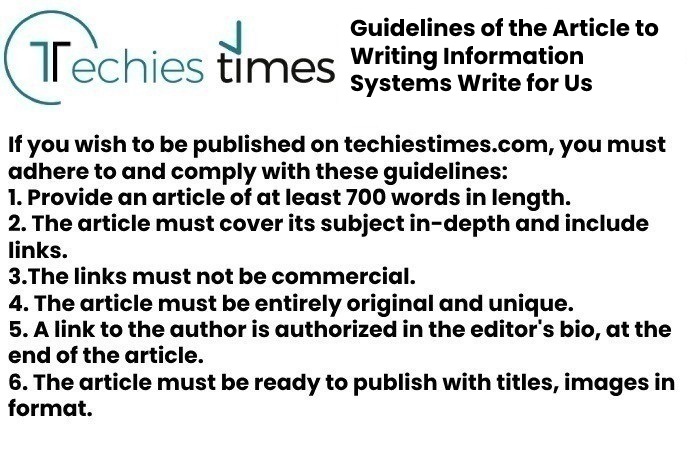Information Systems Write for us
Information systems surround you almost every day. Wi-fi networks on your university campus, database search services in the learning resource center, and printers in computer labs are good examples. Every time you go shopping you are interacting with an information system that manages inventory and sales. Even driving to school or work results in an interaction with the transportation information system.
What is an Information system?
An information system (IS) is an interconnected set of components that collect, store, process, and transmit data and digital information. It is a collection of hardware, software, data, people, and strategies that transform raw data into useful information. An IS supports a variety of business objectives, such as improved customer service or increased efficiency.
People often interchange the term “information system” with “computer system,” but these systems differ. While computer systems are part of an IS, they do not encompass all the components and processes that make up an IS, such as people and processes. “Information technology” is another similar term, but IT focuses on the technical aspects of the hardware and software that support enterprise computing. On the other hand, an IS focuses on how people use IT and data to manage and make decisions within an organization.
In addition to decision-making, IS supports knowledge management and communication. It allows data sharing to take place between different departments, providing consistent data for analysis by a variety of teams. An IS supports various business functions such as accounting, finance, marketing, human resources, operations, and supply chain management. It can also enable new business models and opportunities like e-commerce, social media, and artificial intelligence.
How does an information system work?
An IS is a powerful tool that can bring many different functions together. By connecting system components, it enables IT departments to collect, store, and process information in an efficient way and distribute it for a variety of purposes. The system can also produce reporting in different formats and to various devices. Reports can include text files, spreadsheets, graphics, and complex data visualizations. This comprehensive platform streamlines internal operations and allows businesses to access data quickly and accurately.
The basic process and IS follows includes the following steps:
Input. The system collects data and information from various sources, such as sensors, keyboards, scanners, or databases.
Processing. The system transforms the raw data into meaningful information by applying various operations, such as sorting, classifying, calculating, analyzing, or synthesizing.
Storage. The system stores the processed information in a structured and secure way, such as in a database, a file system, or cloud storage.
Output. The system presents the information to the users in a usable format, such as reports, graphs, charts, or dashboards.
Feedback. The system collects feedback from users and other stakeholders to evaluate its performance and improve its design and functionality. The effectiveness of an IS depends on its alignment with the organization’s goals, reliability, security, and usability.
How to Build an Information Systems Strategy
It would be best if you built your strategy around your goals. When in doubt, turn to your KPIs. Which benchmarks are you failing to hit? For example, maybe you actively market yourself as a customer-friendly solution, but a survey shows customer satisfaction falling 20% below your benchmark.
Once you identify an objective like this, evaluate what information you need. Have you been collecting customer data in a database or data warehouse? Do you have enough to develop a customer retention and satisfaction strategy? If not, it’s time to start from scratch and actively collect customer data.
Plan how you’ll improve your existing system.
There’s a good chance you already have some information systems infrastructure —you need to refine it. For example, you may have plenty of customer data in a data warehouse but lack customer relationship management (CRM) software.
This presents an opportunity to select and customize CRM software based on existing data. When deciding how to improve your system, remember always to keep budget and other resources in mind. Not all plans are affordable.
Design and implement your Information System Write for us
During this phase, you’ll create a list of specifications and requirements your system must meet, varying depending on your company’s needs.
For example, you may consider the following questions:
- How will you collect, consolidate, and access data?
- What software do you need, and how will you customize it?
- Should hardware be updated to accommodate new software?
- How will your applications integrate?
- What parts of your system will be automated vs. managed by human resources?
- Who will head your information systems? The CIO, CTO, or another role?
Your team should then build the functions to bring your system to life. Once you’ve designed everything, it’s time to purchase and install your new mechanisms. This process can be expensive and time-consuming—after all, you’re supplanting your entire organization’s status quo. Be sure to test the system is functioning as planned before rolling it out across your organization.
As you implement your updated system, remember to document every change and keep these records secure. Your developers should also spend plenty of time learning about the users’ needs using the method most. Otherwise, their time may be wasted creating functions that aren’t helpful.
Why your organization needs Information Systems
Information systems are the backbone of data-driven decision-making. It allows organizations to make sense of vast data and use that information to identify and correct procedural issues. Without it, your organization would remain trapped in the same old inefficiencies that hold it back.
For example, by improving its information systems strategy, an organization can centralize its information resources, minimizing confusion and turning a scattered office into a well-oiled machine. This makes both your employees and your customers happier.
How to Submit Your Articles
To Write for Us, you can correspondence at To Submitting Your Articles for my sites is
Why Write for Techies Times – Information Systems Write for Us
What We Look for
Successful guest post contributions should be comprehensive, data-driven, engaging, and educational. To increase your chances of getting published on our blog, ensure that your donation,
- It is a relevant, well-researched post (preferably 1000+ words) with actionable tips.
- It is 100% original and unpublished. We will not republish anything that’s been published elsewhere.
- Only includes claims backed by links to credible research or case studies. Avoid citing our competitors and using any irrelevant promotional links to websites.
- Includes examples and relevant images to illustrate your point. Avoid using stock photos that don’t add any value to the copy. Use Create to visualize data, information, processes, ideas, and frameworks.
- Includes subheadings, bullet points, and shorter paragraphs which make the article more readable.
Topics We Cover
Most of our audience consists of individuals and teams from different organizational departments looking for tips, best practices, and guides on how to work and collaborate visually. As we aim to build a reputable library of information and insights that they can refer to improve and streamline their workflows, we only accept explicit, compelling content falling into the following categories,
- Visual collaboration
- Visual project management
- Business and technical diagramming
- Visual problem-solving
- Visual creativity and communication
- Data visualization
- Design thinking
Search Terms Related to Information System Write for us
- information system
- management information system
- student information system
- what is an information system
- what is an information system
- offender tracking information system
- accounting information system
- student information system msu
- colorado immunization information system
- MSU student information system
- Virginia immunization information system
- human resource information system
- what is the management information system
- inmate information system
- health information system
- marketing information system
- human resources information system
Guidelines of the Article to Writing Information Systems Write for Us

You can send your email to contact@techiestimes.com
Search Terms Related for Information Systems Write for Us
- Information systems guest post
- Information systems blog post
- Information systems article
- How to write an information systems article
- Information systems topics
- Information systems tips
- Information systems examples
- Information Systems case studies
- Information systems resources
You can also use more specific search terms, such as:
- Transaction processing systems are written for us
- Management information systems write for us
- Decision support systems write for us
- Expert systems write for us

